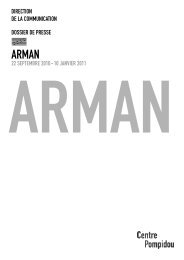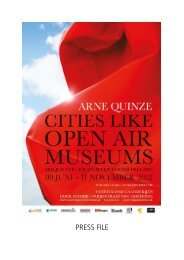Arman - Vicky David Gallery
Arman - Vicky David Gallery
Arman - Vicky David Gallery
Create successful ePaper yourself
Turn your PDF publications into a flip-book with our unique Google optimized e-Paper software.
15<br />
Allure, to go beyond the simple arrangement of the ink-coated object rolling or sliding across a sheet<br />
of paper. The Allure was something that could be sampled: at a rubbish tip, on a beach, in a field of corn,<br />
in the air… It became the artistic transcription of fields of force, of currents, of intrinsically ephemeral<br />
phenomena. The procedure opened up perspectives beyond the pictorial domain; the extrapolation of<br />
the modus operandi led <strong>Arman</strong> to conceive of real and spectacular performances: “I dream now only of<br />
covering a lorry with Indian ink and crashing into a sheet of paper. Salvador Dalí with his snails and<br />
sea-urchins had touched on the truth but his approach is vitiated because he privileged the literary idea<br />
above the concrete pictorial result”. 23 The scale of the action envisaged and the force of the verbal<br />
description indicate the violence that <strong>Arman</strong> hoped to confer on his gesture, which has to be reconsidered<br />
in relation to the “informal vehemence” of Mathieu, Murakami and Shiraga. 24<br />
Relations between Pierre Restany and <strong>Arman</strong> were extremely close as the artist’s career began to take<br />
off: it was Restany who wrote the catalogue essay for the show at the Galerie Saint-Germain in 1960, and<br />
then for the show at the Galerie Schmela. He acted as a coach: “He’s got a whole plan for me, and I am<br />
officially on his team, along with Hundertwasser, Bellegarde and two or three others”, wrote <strong>Arman</strong>. 25<br />
On the other hand, relations between <strong>Arman</strong> and Schaeffer remained distant and complicated. <strong>Arman</strong> got<br />
nothing in return for his intellectual commitment to concrete music; although Schaeffer was interested in<br />
cinema and television, he didn’t have much time for painting. <strong>Arman</strong> never felt as if he had been entirely<br />
accepted by the Schaeffer circle, and felt condescended to by the composer. Given Schaeffer’s refusal<br />
to have Éliane Radigue at the GRM, she chose to go and work with Pierre Henry, also not welcome there.<br />
In October 1959, <strong>Arman</strong> noted that they could not “travel their roads together” for many complex reasons. 26<br />
<strong>Arman</strong> was involved with GRM activities in so far as he was making a film with Jacques Brissot, based<br />
on his Allures d’objets, to be filmed and edited by Brissot. <strong>Arman</strong> and Brissot would have great difficulty<br />
in convincing Schaeffer to allow them to use his composition Étude aux sons animés to accompany their<br />
film, Objets animés. Even though the project was entirely orthodox in concrete music terms, it was treated<br />
as suspect, and it was only through Restany’s intervention that Schaeffer was persuaded to allow his<br />
music to be used. A few months later, the founder of the GRM changed his opinion of the film, boasting<br />
of its success in Les Cahiers du cinéma (see this cat. p. XXX). The film had joined the GRM’s pantheon of<br />
contemporary artistic achievements, yet relations between Schaeffer and <strong>Arman</strong> had more or less broken<br />
down.<br />
<strong>Arman</strong> himself offered an explanation for the sudden take-off on his career: “In 1959 everything happened<br />
at the same time. I was like a cannon packed with gunpowder and just waiting to go off. My language<br />
came together, different aspects came together”. 27 He experimented with the Allures by introducing<br />
“accidents” in which objects got broken. He imploded electric bulbs plunged in Indian ink; this produced<br />
a centripetal Allure of a new kind. From now on, <strong>Arman</strong> would take his distance from the methodology of<br />
the concrete, which privileged structure and with it an object that had no artistic value in itself. Yet in an<br />
Allure-Colère and a fortiori in the later Colères, if the object is now present it is at the conclusion of a<br />
process of disintegration resulting from the deliberate and organised activity of the artist. The Cachets had<br />
marked a first break with abstraction and with painting. The principle of accumulation effects a second<br />
break, with informal painting and with the methodology of concrete music as a way of articulating the<br />
internal language of the object, affirming the object in its integrality but under conditions of multiplication<br />
and of confinement within a given volume. 28 This is the inverse of the principle of the Allure, in which the<br />
object found itself in a situation of spatial expansion, and a return to the all-over composition introduced<br />
with the large Cachets.<br />
When Otto Hahn compared the violence of Gutai to his, <strong>Arman</strong> responded: “In my case gesture led me to<br />
the object; having broken a saucer on the canvas, I kept the pieces and glued them into the work. I entered<br />
into the logic of the object. I used all kinds, and I had drawers full of cogwheels and radio valves. One day<br />
in 1959, I felt that a drawer full of lamps made a complete work. I fixed a sheet of cellulose acetate on top,<br />
painted the sides black and showed it like that. It was my first Accumulation”. 29<br />
Yet to present the Accumulation and the Poubelle as sudden discoveries is to forget the importance of the<br />
superimposition of different procedures in <strong>Arman</strong> and the deeper-lying sources that were in fact involved.<br />
The large Cachets were already graphic accumulations. What is more, the artist himself correctly explained<br />
that the world of the Accumulation had been latent in him since childhood, its origin being the principle<br />
of collection, an ancestral family trait, with a grandmother who saved corks and a father who had antique<br />
furniture shops in Nice, where <strong>Arman</strong> himself worked for eight years of his life. Like some psychic state,<br />
the Accumulation passed from latency to activity in 1959, to become an artistic language.<br />
Indeed, the Accumulation had been patent as early as 1957, in the form of a poetic creation, when <strong>Arman</strong><br />
wrote: “Croisons les fers à souder de nos yeux et du chaud métal affectif, coulons l’enclume de nos<br />
passions et de notre rage martelante de ne pas donner plus en notre humain amour” (Let us bring together<br />
the soldering irons of our eyes and of hot metal emotion, let us cast the anvil of our passions, of our




